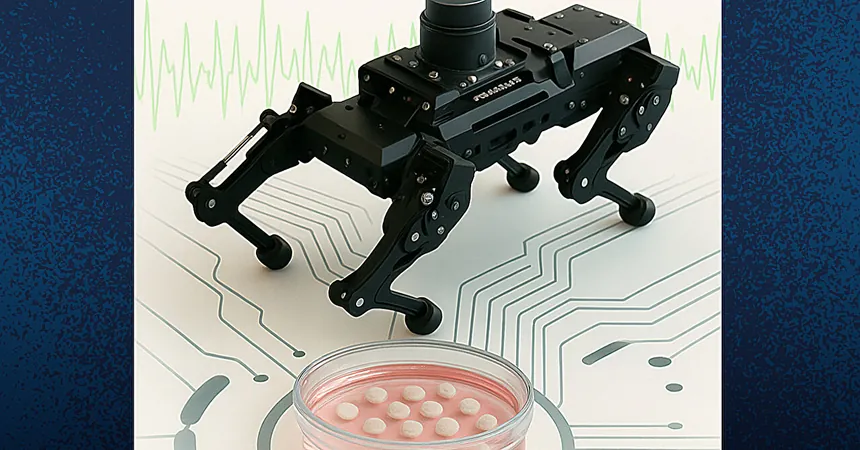
Unlocking the Future of Brain Research: Graphene Tech Supercharges Brain Organoids
2025-08-20
Author: Li
Revolutionary Breakthrough in Neuroengineering
A groundbreaking study from the University of California San Diego Sanford Stem Cell Institute has introduced a game-changing technique to speed up the maturation of human brain organoids using graphene, an ultra-thin yet powerful sheet of carbon.
Introducing GraMOS: The Future of Brain Organoid Development
Published in the esteemed journal Nature Communications, the research details Graphene-Mediated Optical Stimulation (GraMOS). This innovative method presents a safe, non-genetic, and biocompatible way to influence neural activity for extended periods—vital for understanding age-related diseases like Alzheimer’s.
Dr. Alysson Muotri, who led the study, declared, "This is a game-changer for brain research! We can now enhance brain organoid maturation without genetic alteration, paving the way for advancements in disease research and brain-machine interfaces."
Why Traditional Methods Fall Short
Brain organoids, 3D models created from stem cells, have become essential for studying neurological disorders, yet their slow maturation often limits their utility. Conventional stimulation techniques have either required genetic tweaks via optogenetics or risky direct electrical currents.
GraMOS cleverly utilizes graphene's remarkable properties to convert light into gentle electrical signals, encouraging neurons to connect and communicate naturally. This non-invasive approach mimics real brain stimuli, promoting development without harm.
Key Findings That Could Redefine Neuroscience
The study revealed that GraMOS dramatically accelerates brain organoid development, resulting in improved connectivity and network organization among neurons, even in Alzheimer’s models.
Notable findings include: - **Accelerated Development**: Organoids matured faster, achieving stronger connections and advanced communication. - **Safety First**: No adverse effects on neurons or organoid structure were observed, even with prolonged use. - **Enhanced Disease Modeling**: Stimulated Alzheimer’s organoids displayed distinct functional variances in network activity. - **Robotic Control**: Organoids were successfully linked to a robot, showcasing real-time responses to visual stimuli.
A New Era for Alzheimer's Research and Beyond
With the ability to stimulate brain organoids more effectively, researchers can now investigate disease progression in a timely and physiologically accurate manner, streamlining drug testing and revealing how diseases hijack brain connections.
Dr. Alex Savchenko emphasized, "Our technology fills a significant gap in organoid research, offering a reliable method to activate neurons that could transform neuroscience and its applications."
Neuroplasticity Meets Robotics: Shaping a New Future
Graphene-enhanced brain organoids aren't just lab curiosities; they respond dynamically to their surroundings, displaying neuroplasticity that surpasses traditional computer chips. This sets the stage for future AI applications where living tissues can help solve complex issues and adapt to changing environments.
In an incredible proof of concept, researchers connected graphene-engaged brain organoids to a robotic system. The system was able to alter its path in under 50 milliseconds upon receiving cues from the stimulated organoid, showcasing a seamless human-robot interaction.
Paving the Way for Future Innovations
While we aren't close to developing conscious machines just yet, this development hints at a promising future where neural tissue and robotics collaborate for enhanced prosthetics, adaptive interfaces, or innovative computing methods.
This study not only marks a substantial leap toward integrating graphene into neuroscience and neuroengineering but also opens the door to innovative therapeutic strategies for tackling neurodegenerative and cognitive disorders. With the capability to stimulate and accelerate brain organoid growth, researchers are better equipped to develop new treatments.
Looking ahead, this approach could also be adapted for tissue engineering, creating a precise, noninvasive way to stimulate lab-grown tissues. By connecting living networks to machines, we might unlock the brain's adaptability and learning potential, potentially revolutionizing artificial intelligence.


 Brasil (PT)
Brasil (PT)
 Canada (EN)
Canada (EN)
 Chile (ES)
Chile (ES)
 Česko (CS)
Česko (CS)
 대한민국 (KO)
대한민국 (KO)
 España (ES)
España (ES)
 France (FR)
France (FR)
 Hong Kong (EN)
Hong Kong (EN)
 Italia (IT)
Italia (IT)
 日本 (JA)
日本 (JA)
 Magyarország (HU)
Magyarország (HU)
 Norge (NO)
Norge (NO)
 Polska (PL)
Polska (PL)
 Schweiz (DE)
Schweiz (DE)
 Singapore (EN)
Singapore (EN)
 Sverige (SV)
Sverige (SV)
 Suomi (FI)
Suomi (FI)
 Türkiye (TR)
Türkiye (TR)
 الإمارات العربية المتحدة (AR)
الإمارات العربية المتحدة (AR)